Way back in April 2007 I released Episode 84 of the Martin Bailey Photography Podcast, in which I spoke about 10 items that I would really not like to be without, in my photography. Just over two years have passed, and I have a few more things that I feel compelled to talk about today. It’s difficult to find another ten items but there are a number of things that I would like to show you, and I’ll also update you on the things from that first Podcast, and whether or not I’m still using them two years on, which really is the true test of whether something is useful or not.
If you want to check the images of the things that we talk about and you’re near a computer, go to Episode 84 on my Podcasts page and you’ll see the thumbnails for images of the ten things we’ll talk about first today.
The first thing I spoke about two years ago was my Angle Finder C. This is an accessory from Canon that you attach to the viewfinder of your camera to allow you to look down into the camera from above or from the side etc. I still carry this with me whenever I go out shooting. I perhaps don’t use it quite as much as I used to, because I now use Liveview quite a lot, but still, when shooting with the camera right down close to the ground I reach for the Angle Finder.
I also talked about the little spirit level that goes in the flash shoe on top of the camera, to help get the camera straight. I actually lost the one in the photos that we looked at two years ago. If I recall I lost it in the snow during last winter. I since bought two more. I hated not having the bubble for the rest of the trip on which I lost it, so I now carry two of these things, just in case. I also sometimes shoot with two bodies, both on tripods, so having two comes in handy then as well.
I’m still using my Gepe Card Safe Extreme Memory Card cases. These have actually become more useful since I bought the 1Ds Mark III because that also uses SD cards, which, although I swore I would never use, since they became much faster I now have three. The beauty of the memory cases that I have is that you can put both SD cards and CF memory cards in the same slot, so I can have up to four CF and four SD cards in the same case, so I’m getting more use out of these cases now than two years ago.
I still carry the filter removers that I mentioned, but I don’t think I’ve actually used them in the last few years. The thing about these though, is as soon as I don’t take them with me, you can be sure I’ll get a filter stuck. I’m sure that the inanimate objects that we own are all able to communicate in some way, because they sure seem to know when you are vulnerable.
I’ve used the Sto-fen Omnibounce a few times over the last few years, though I’ve not done a lot of shooting where I need diffused flash on the camera. I find this most useful when you need to diffuse light either directed straight at the subject or bounced off a wall or ceiling, in relatively fast paced shooting. If I recall I did use this on assignment last August, when I photographed the lacquer gatherer, as I needed to use on camera flash, but didn’t want any nasty harsh shadows.
My compass still gets plenty of use. I used this most recently to get lined up waiting for the moon to rise, using the azimuth that my favourite iPhone app Velaclock tells me the moon will rise at.
I still use the blower that we see there, and actually recently bought a smaller one to go into my pouch for when I’m out and about. The big one that we looked at in Episode 84 is more for when I’m cleaning gear or my sensor at home, before setting out for a shoot.
Wimberely’s plamp, the plant clamp still goes out with me whenever I’m going to be doing macro work. This is used to clamp the stem of a flower without harming it, and you clamp the other end to your tripod leg, to stop the plant from swaying around in the breeze. I have two, and still use them quite a lot.
Again for macro work, especially with the 65mm 1-5X macro lens from Canon, I still use my focusing rails from Really Right Stuff, that we also looked at.
The WalkStool still goes out with me when shooting flowers or when I may be just sitting around for long periods of time, waiting for birds to show etc. The WalkStool is light, but has telescopic legs so can be used very low, or at a normal sitting height, and is relatively comfortable. It can save your back when shooting in an awkward position, so definitely still part of my kit.
Actually, looking at my notes, I see that I also mentioned the WhiBal which takes us to eleven things. The WhiBal still very much a part of my workflow, when I have to get white balance totally accurate. I mentioned this just last week in fact. Great tool!
So, let’s move on to six things that I wanted to mention today. The first thing is something that I mentioned I was thinking of buying in the last Podcast in April 2007, and that is a pair of knee pads. These knee pads are made by a company called Hatch, and as you can see from the image, they get a lot of use. I take these out with me when I am going to be shooting flowers or macro shots, and generally strap them on when I’m going to be kneeling a lot. The reason I use these is twofold. Firstly, I’m trying to protect my trousers. I often end up kneeling on rough surfaces, gravel or tree roots etc. and these things can gradually damages your trousers. Also though, when you are carrying too much weight, like I am, uneven surfaces can actually be quite painful on the knees, and even if the surfaces are smooth, kneeling on a hard surface for a long time can start to hurt after a while.
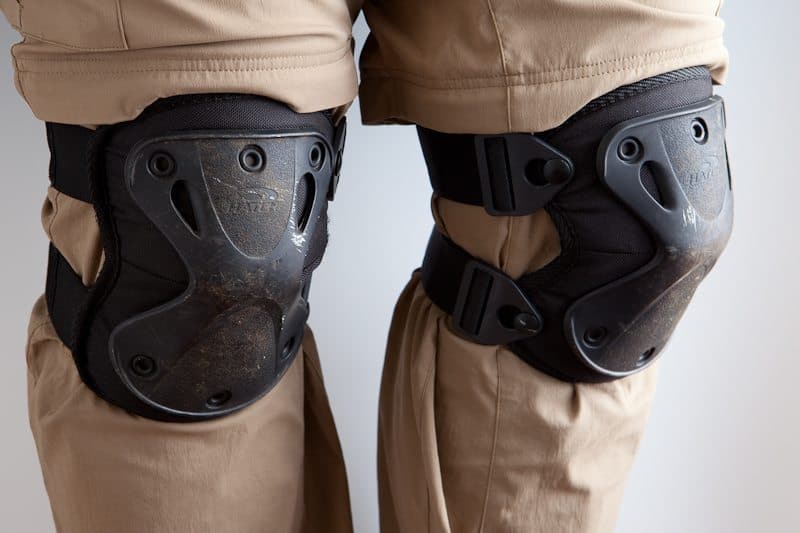
Hatch X-TAK 100 Knee Pads
I made a comment on a focus ring podcast many moons ago, that I look like a forty year old fat sk8boarder with these on, and nothing’s changed, except I know look like a forty two year old fat sk8boarder. Still, like my shooting vest, I’d rather look a bit silly than lose shots because of my knees hurting, or not kneeling down because I’m worried about ripping my trousers. All of the new things I talk about today have links in the show-notes by the way.
Next up, is the Black Rapid R-Strap, or R-Straps. I actually bought two of these before going to Hokkaido this year. The R-Strap is a great camera strap that you actually screw directly into the tripod mount screw thread on the body of the camera or the tripod mount ring on larger lenses. I actually have plates on all of my camera bodies and lenses, and because I use Really Right Stuff plates, which have a screw thread, I can screw directly into the plates, which saves me from having to take the plates off every time I use my R-Straps. That is very important in my opinion, because you really don’t want to be messing around with plates all the time. I want to be able to unscrew the R-Strap and put the lens and camera on a tripod quickly too.
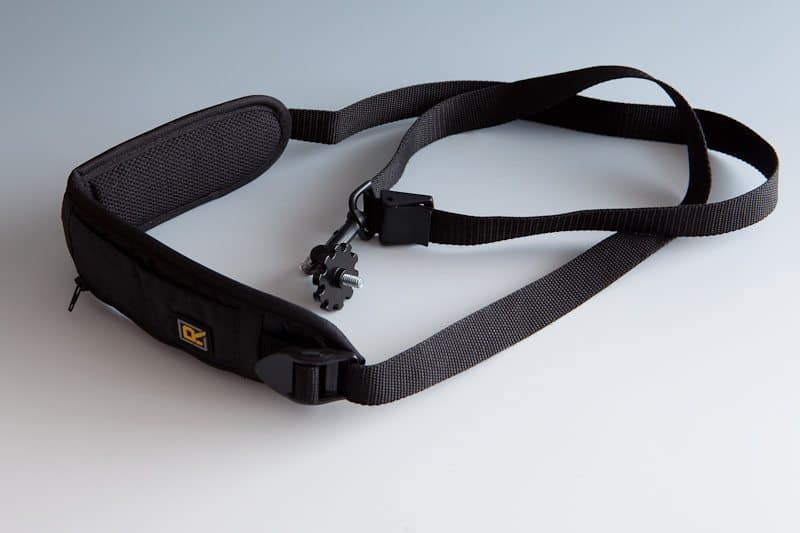
Black Rapid R-Strap
There was a downside of the R-Strap originally, and that was if you unscrewed the strap but left it hanging around your shoulder, the large knurled nut that you use to tight the R-Strap in place came lose, and would fall to the floor without you realizing it. I lost one of mine in Hokkaido this year, and I think I recall Forrest Tanaka of our community saying that he lost his as well. The new R-Straps no long have this problem though, I think. The R-Straps that are shipping now have a FastenR-2, which incorporates like a rubber washer that looks from the photos to be pretty much stuck on there, and probably won’t fall off. Black Rapid have also updated the connector that is used to connect the strap to the FastenR-2. This is now called the ConnectR-2, and has a better locking system than the old one, where you basically had to slip a piece of rubber hose over the clip to stop it from opening, potentially sending your camera crashing to the floor.
I bought two of these straps because I wanted to be able to carry two camera’s at once, but ever the innovators, Black Rapid recently released the RS- DR-1 Double Strap, which basically enables you to hang two bodies from the strap, without having to wear separate straps, crossed around your shoulders as I was doing. Using two straps to be honest was not all that comfortable, so I’m really pleased to see the Double Strap, and have promptly ordered one, along with some replacement FastenR and ConnectRs for my original R-Straps. I’m going to keep them all, as I will continue to use the single R-Strap when I don’t carry two bodies. I’ll only use one at a time of course now, because when I carry two bodies, I’ll use the Double Strap. Great innovation here from Black Rapid and once again this is proof that my impatience and eagerness to jump on new technology pretty quickly sometimes costs me more than necessary as things get innovated.
Before we move on, I wanted to take a look at a second photo of one of my Black Rapid R-Straps, which I have customized a little. I bought a Really Right Stuff quick release clamp, and bought some bits and bobs from the hardware store to allow me to hook a quick release clamp on to the R-Strap. One of the things that I still don’t like about the R-Strap is that you have to spend time screwing it on and off, and this is a pain when you switch from the R-Strap to shooting from a tripod, which I do regularly when shooting wildlife.
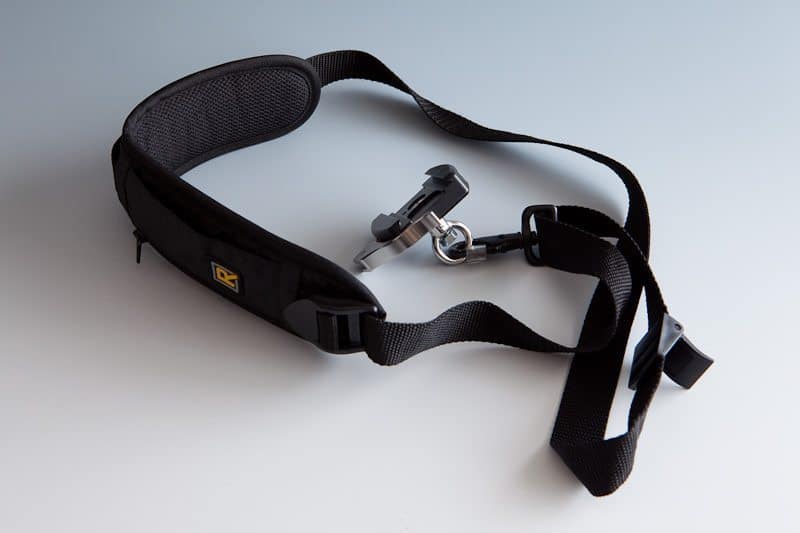
Customized Black Rapid R-Strap
Next up is the LED LENSER flashlight. We looked at a photograph of this little beauty last week, but I’ve posted the photograph again in today’s podcast’s blog post. My LED LENSER flashlight is the P7. I chose this based on price/performance. The main use that I have for this flashlight is to shine onto somewhat distant objects to aid autofocus. The great thing about this flashlight is that it has what they call a Speed Focus mechanism, where basically you can push or pull the front element of the flashlight back and forth, and as you do so, it focuses the light into a small beam that goes a long way, or a broader, but weaker beam. There are also two brightness modes. The button to turn the flashlight on is at the back, so you push it with your thumb, and if you push and hold the button down, the beam is bright, but then as you let the button go, it drops down to a slightly dimmer mode initially. If you want the brightest mode full time, you push the button again and let go. A third push of the button turns the flashlight off.
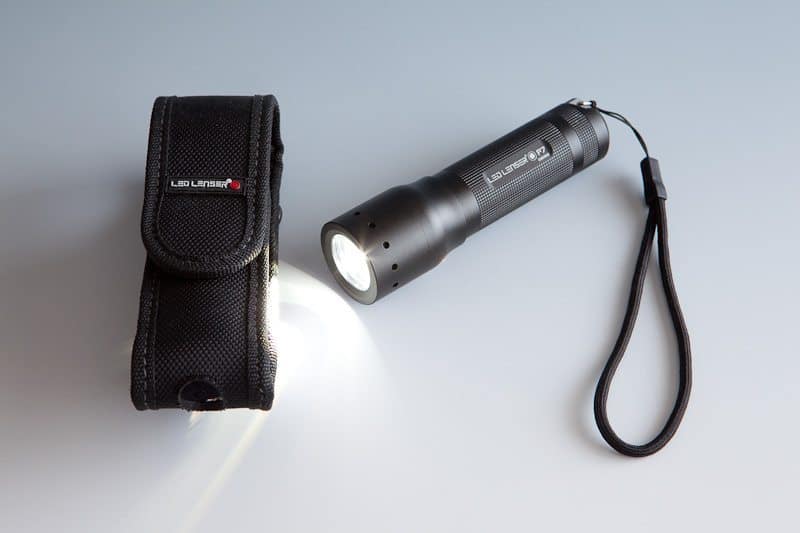
LED LENSER P7 Flashlight
Because the light is created with LEDs and not conventional bulbs, the light is pretty cool, so I have also used this to pop a bit of light into a macro shot. I didn’t like the image because of other reasons so I didn’t post it to my gallery, but it’s a viable use for this flashlight in my opinion. Also, of course there’s also the option of doing a bit of painting with light, which the P7 is definitely powerful enough for.
I have a small LED headlamp that I use when I need to illuminate my camera in the dark to change settings or change lenses etc. and I’ll continue to use this. The old powerful flashlight that I used to use for focusing on distant objects was pretty bulky and used a standard bulb, with big batteries, that didn’t last that long. It was pretty heavy too, so not really something that I could put in my pocket. The LED LENSER P7 comes with a case that has a belt loop, so I can keep it on my belt, making it almost disappear until I need it. It has an effective range of 738 feet, or 225 meters, and has a very, very bright light, but despite the power of the thing, it’s rated to give me 78 hours of light with three triple A batteries, which I think is just amazing. You can use rechargeable batteries too, which helps to keep us green. I really like to avoid using disposable batteries, and now that rechargeable batteries are so powerful, it really is a valid option.
I’ve mentioned a few times in the forum, but don’t think I’ve ever really spoken about my photographer’s vest in the podcast. I actually have two photographer’s vests that are identical. I have two, because I sometimes use the vests on long multi day shooting trips, and want to be able to change it out during the trip, especially during the warmer seasons where you can get a bit sweaty sometimes. I use two identical vests so that I don’t get disorientated when I switch. If they had a different pocket lay-out or different types of fastener’s etc. it would almost certainly cause confusion, and I might not be able to get at a piece of kit as quickly as I’d like to, and may end up missing a shot, very similar to always putting your lenses in the same position in the camera bag to keep things consistent. I can fit large lenses like the 70-200mm F2.8 in the inside flaps of my vest, and standard zooms like the 24-70, or the 100mm macro lens fits nicely into each of the front pockets. I generally get to my location with the gear in my camera bag, but then take out the lenses that I think I’m mostly use and put them into the vest pockets, often along with a 1.4X extender and extension tubes, and then shoot mainly from my pockets, only going back to the bag for things that I didn’t anticipate needing initially. My vests also have a mesh back, with a full cloth back that can be removed in the warmer months. With that welcome little innovation, I’m even able to use the vest in heat of the Japan summer.
Next up is my Gitzo Four Season Jacket. As we get into the summer it’s probably not the best timing for this one, but again, for the Hokkaido trip this year I bought a Gitzo jacket which when used with good fleeces and warm undershirts etc. is really quite warm, due to the wind proofing and some limited padding. Gitzo also does a fleece that goes with the jacket for full winter warmth, but I didn’t get one of those. I have enough standard fleeces which I quite like and didn’t want to add extra unnecessary layers. The cool thing about the Gitzo Four Season Jacket is that it’s basically a camera bag that you wear.
There are large pockets on each side at the front that when expanded can take two large lenses each. There are plenty of other pockets for other knick-knacks as well, including two large inside pockets that I used for keeping lens cloths, spare batteries, filters and just about anything else that I usually keep in my bag. The coat is pretty long, so it also has zipped flaps on the sides to allow you to get to the inside pockets and your trouser pockets without having to unzip the front of the coat. These zips also allow you to kneel down without putting stress on the jacket, probably ending up in you ripping the seams. There’s a whole bunch of other features too, like a flap that comes out of the hood to cover your camera when it’s raining, and protective padding on the elbows for when you get down on the ground. There’s also padding on the shoulders to make carrying your camera or anything else on your shoulders more comfortable. There are reflectors and press badges included too. Gitzo really did think of everything when designing these jackets.
Are they the photographer’s dream jacket? Not yet. Unfortunately Gitzo decided to scrimp on the quality of the zips. Two of the zips on my jacket were constantly jamming, and especially when you’re in very cold weather, it was simply not possible to un-jam these zips on occasion. It wasn’t because of the cold of course. They jammed indoors as well. This drove me crazy in Hokkaido this year. Another participant also bought one of these jackets for the trip, and had exactly the same problem so it’s almost definitely a flaw in the jackets. If Gitzo were going to go to the trouble to create something that does promise to be the photographer’s dream jacket, surely they could have gone the extra mile and made sure that all of the components of the jacket were top quality, especially as they’re charging top dollar for these things. If anyone from Gitzo listens to this Podcast, the only way you are going to get me to fully endorse this product is to allow me to send you my jacket, and replace the zips for better quality ones.
You might think I’m being hypocritical by including this jacket in my things I would not like to be without podcast after what I just said, and I tend to agree with you. Having said that, if the zips were better quality, this really would be a winner.
Finally, I wanted to mention my Really Right Stuff Long Lens Support. One of the biggest problems with long lenses, is that they shudder when you release the shutter, and this sometimes results in some of the images shot being a little bit soft or even blurry. When shooting with my 600mm F4, which is the lens we can see in the picture on the blog, I usually put my hand over the top of the lens, and apply a little downward pressure to help prevent this, at the same time, I put my finger on the button near the front of the lens, as I have my cameras set up to toggle between One-Shot and AI Servo focus. Applying some downward weight helps, but still I wanted something more to stop that shudder, and then one day, I was browsing through Really Right Stuff’s catalog, and saw the Long Lens Support that you see here.
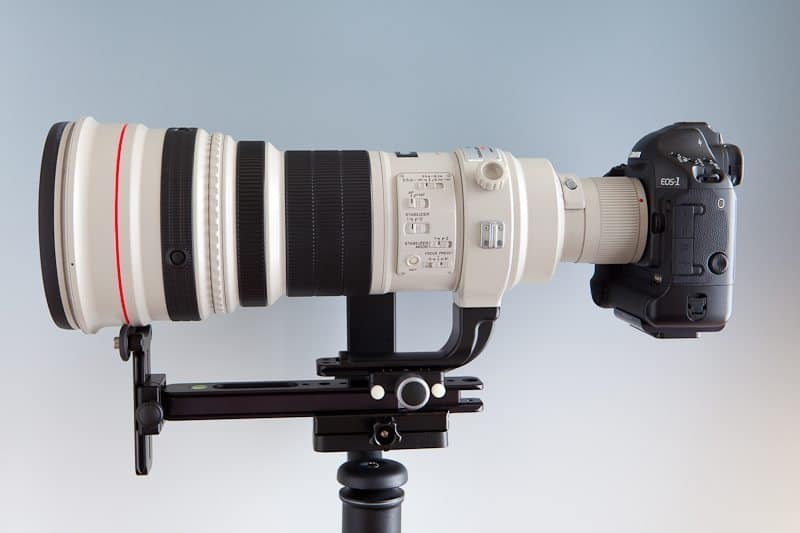
600mm F4 with Long Lens Support CP-YS-QR-Pkg
This basically enables you to support the lens not only with the lens collar, but also from the front. You adjust the height of the support at the front, to that it pushes the lens up a little, and that is enough to greatly reduce the shudder, and help you to get tack sharp images. The support that you can see touching the front of the lens actually has little rubber wheels on it that turn, so you can loosen the lens collar and turn the lens into portrait mode, and the wheels turn smoothly, without marking or damaging the lens, it’s really well designed. I still put my hand over the top when shooting wildlife, but this has greatly improved sharpness. The support can be used with the 300mm and even the 70-200 F2.8 lens, if you put the front support up against the lens hood. It’s not as necessary with the 70-200 of course, but I believe the 300mm F2.8 lens does benefit some from using this support. I don’t use it all the time with the shorter lenses, but it’s a permanent feature now when shooting with the 600mm F4.
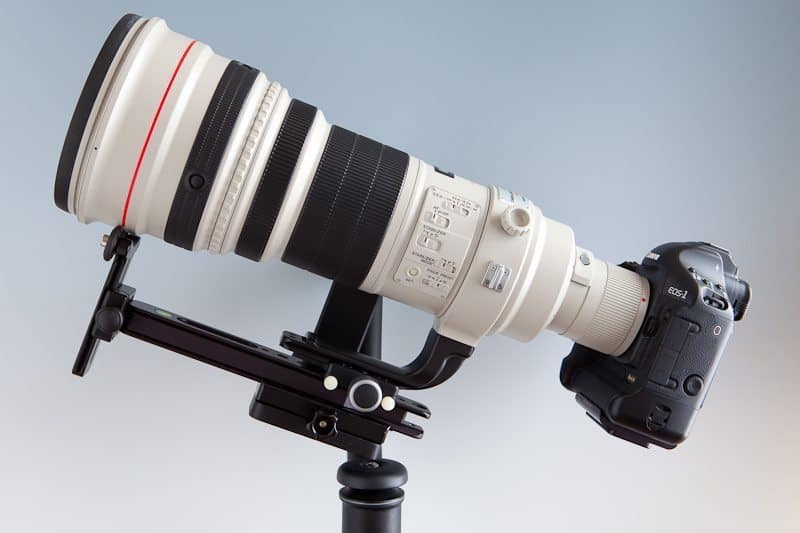
600mm F4 with Long Lens Support CP-YS-QR-Pkg
You’ll also notice from the additional two images that once balanced on the Wimberley Head, you can effortlessly swing the whole set up around, and when you let go, it stays exactly where it is. It’s perfectly balanced. This is helped also by using the Really Right Stuff replacement foot, as this lowers the total height of the lens a little. The foot that comes with the 600mm is a little higher, and makes balancing like this difficult with the Long Lens Support as well because it all gets too high.
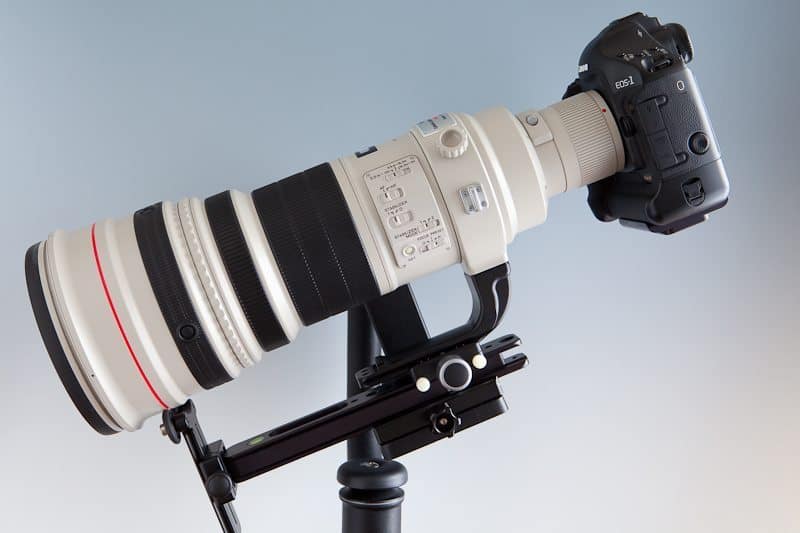
600mm F4 with Long Lens Support CP-YS-QR-Pkg
So, that’s about it for now. There are a few things that I thought about adding but didn’t, like my Better Beamer, but I haven’t really used it enough to be able to say that I can’t live without it. I’ll do that in a follow up podcast at some point, when I feel comfortable that I am really using it.
Podcast show-notes:
Hatch X-TAK 100 Knee Pads: [Removed invalid link]
The Black Rapid Web site: http://blackrapid.com/
The LED LENSER P7 flashlight: http://www.ledlenserusa.com/product_info.php?modelNum=8407
The Gitzo Four Season Jacket: http://www.gitzo.com/Jahia/site/gitzo/pid/17148
The Really Right Stuff Long Lens support: http://reallyrightstuff.com/rrs/Customkititems.asp?kc=CB-YS-QR-Pkg&eq=
This episode is sponsored by WebSpy, the Internet Monitoring, Analysis & Reporting Specialists.
The music in this episode is from the PodShow Podsafe Music Network at http://music.podshow.com/
Audio
 Subscribe in iTunes for Enhanced Podcasts delivered automatically to your computer.
Subscribe in iTunes for Enhanced Podcasts delivered automatically to your computer.
Download this Podcast in MP3 format (Audio Only).
Download this Podcast in Enhanced Podcast M4A format. This requires Apple iTunes or Quicktime to view/listen.

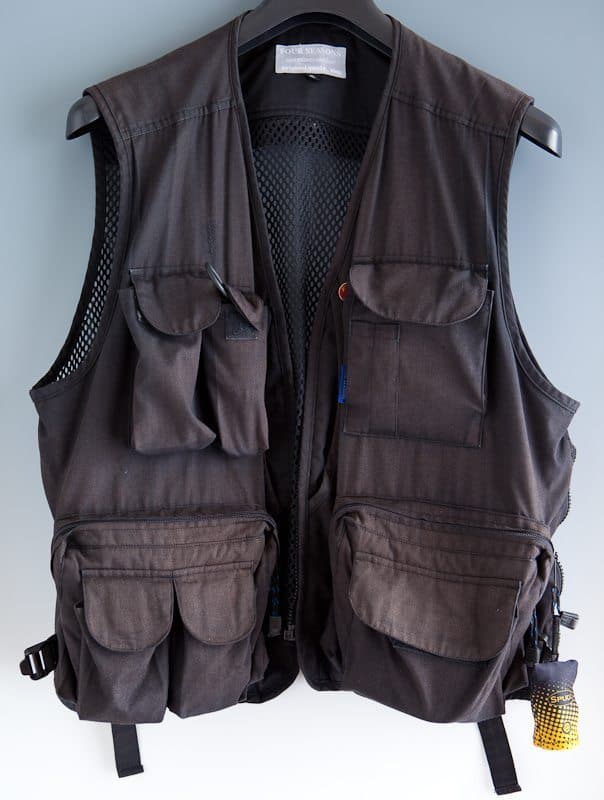
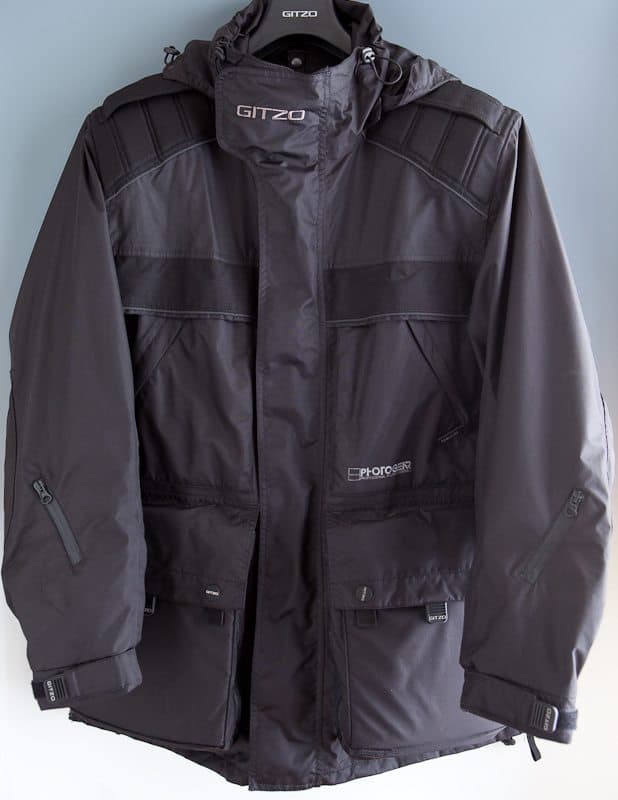

Hey Martin. I have problems listening to this episode on my Ericsson P1i cell phone. I have downloaded it a couple of times from iTunes. I also donwloaed it from your blog, same problem. Listening to the same downloads from my computer works just fine. In 99% of the cases, it works just fine listening to your podcasts on my cell phone, but not this time. I have had similar problems a few times before with your podcast. This is no biggie for me, I will listen to it on my computer for a change. Don’t kill yourself to solve this minor issue. I just thought you might wanna know. Take care and keep up the VERY good job.
Hi Mikael,
I see here that you can listen to most Podcasts on your phone, but some cause problems. Please confirm that either your phone supports Enhanced Podcasts, which are M4A format, or that you are downloading the MP3 versions. If you are getting the right file format for your phone, please try removing the images from the Artwork tab under file information, when you right click the image in iTunes. Then transfer that to your phone and see if it still doesn’t work.
If that doesn’t work, I really can’t think of anything that might be causing this. Conversely, if anyone else reading this has information on what might cause this, please let us know.
Martin
Great new blog and so good to have some MBP content to tide us over between podcasts!
Thanks as always for sharing your photography gear recommendations with us.
Hey Martin,
Once again, brilliant podcast and blog entry–as the person who turned you on to the Gitzo Jacket ;-P I have also have to concur with your evaluation of the zippers. The one on the left side vent under the sleeve derailed on mine, and since it’s one of the waterproof variety (i.e., it’s got fabric flaps threaded through the zipper runner) I can’t get it repaired at a drycleaner or tailor like I can with normal run-of-the-mill ones. Pain in the arse, to say the least.
As for the vest, I personally prefer using ThinktankPhoto’s Modulus Speedbelt system–totally modular, loadbearing and even more breathable than a mesh vest. I even have it rigged with a quick-release holster for my Gitzo tripod so I can whip the thing out one-handed and set up within 7 seconds.
I also recommend Surefire tactical flashlights for AF assistance at night, particularly the LX2 Lumamax –light(only 3.75 ounces) and super-bright (200 lumens–that’s REALLY bright!).
Incidentally, for dark places where you can’t use a tripod or monopod, I find the Kirk Foot Strap indispensable–you just attach via a screw or QR plate to your camera body and step on the strap, creating line tension that can be used to stabilize the camera and virtually eliminate camera shake. It works really well, and is only USD39 for the QR version–highly recommended!
-Jon
Thanks David! I’m pleased you like the new blog, and it’s always a pleasure to share my recommendations.
Jon, I do hold you totally responsible for my Gitzo zip problems. 🙂
I tried the Lowepro belt system, and didn’t really like it. I couldn’t get enough lenses on the belt to keep me happily shooting, and that’s even with my circumference advantage. 😉
The Surefire tactical flashlights sound cool. The brightness is the same as my LED LENSER P7, at 200 lumens, and I agree, that is bright! It’s plenty for what I need.
The Kirk Foot Strap sounds good too. I’ve heard of this method before, but just using string. I’ll have to check that out.